1/48 Dragon Fw-190A “opened up”
Heinz Bär - Experte:
As an air-minded working-class teenager, Heinz Bär took up the sport of gliding and soon became a qualified powered aircraft pilot at age of 17. With hopes of eventually flying for Deutsche Lufthansa, he joined the Luftwaffe in 1937, graduating from flight school in early 1939 with a promotion to Feldwebel for his performance as a student. The quality of prewar training would be evident throughout his wartime career.
Sent to JG 51, Feldwebel Bär scored his first victory - a French Hawk 75 over the Western Front - on September 25, 1939. Because he was flying Weiss 13 when he did this, Bär decided that 13 was his lucky number; almost all his later aircraft would carry this number whenever possible. When Werner Moelders was promoted to Geschwader Kommodore of JG 51 just before the beginning of the Battle of Britain, he chose Bär as his wingman. Bär went on to score ten victories during the Battle, and became a flight leader by the end of the year. JG 51 re-equipped with the Bf-109F during the Spring of 1941, and Bär continued to score regularly as the RAF began to “lean into France” with heavily-escorted daylight raids by a flight of Blenheims, which were attempts on the part of the RAF to draw the Jagdwaffe into combat.
JG 51 moved east to participate in Operation Barbarossa, and Bär scored spectacularly from the first day of the invasion. On July 2nd, 1941, with a score of 27, he was promoted from Feldwebel to Leutnant and awarded the Knight's Cross. By August 14th, his score stood at 60. He was promoted to Oberleutnant and awarded the Oak Leaves to the Knight's Cross, along with a promotion to Kommandeur of the new IV Gruppe of JG 51. On August 28, he was shot down 50 kilometers behind the Soviet lines. Despite a double fracture of his spine, he made it back to German territory.
Bär, now a Hauptmann with a score of 90, was awarded the Swords on February 16th, 1942. Shortly after, he was promoted to Major, and promoted to Geschwader Kommodore of JG 77, based in Sicily. He fought over North Africa with the unit, and also over Sicily and Italy, raising his score to 133 against both the RAF and USAAF, despite suffering from ulcers and malaria. He was evacuated back to Germany shortly after the Italian surrender in September 1943. Shortly thereafter he became Gruppen Kommandeur of Jagd Gruppe “Sud” and managed to take part in several of the air battles over Western Europe in the Fall of 1943.
Bär participated in the “Revolt of the Kommodores” when Goering blamed the Jagdwaffe for failures against the Western Allies in Europe and the Mediterranean. His attitude of forthright honesty in an organization whose high command was so thoroughly corrupt earned him Goring's enmity. In December 1943, he was reduced to Staffelkapitaen with II./JG1 at Woensdrecht in Holland, the only Major in the Luftwaffe flying such an assignment. Oberstleutnant Walter Oesau, who had recently assumed command of JG 1 took him for his skills and to get him away from Goering's vengeance. Bär took the assignment gratefully and gave support to his inexperienced and lower-ranking Gruppenkommandeur. As the Eighth Air Force's daylight offensive grew in power in the early months of 1944, with JG 1 based directly in the path of the American missions, Bär became a “Fortress specialist.” As a master of the “Twelve O'Clock High” massed head-on attack against the bomber formations, flying the more heavily-armed Fw-190A-7, by mid-March 1944, he was credited with 14 B-17 and B-24 victories and was promoted to Gruppen Kommandeur of II/JG 1.
Eventually, Bär shot down 21 B-17s and B-24s during his tour on the Western Front. On April 22, just after returning from an interception of heavies on their way to bomb Hamm, a lone B-24 was sighted northwest of the field at Stormede. Bär sprinted to his reserve Fw-190A-7 - Rot 23 - and took off with his wingman, Oberfeldwebel Leo Schumacher. After a 15-minute chase and battle, Bär scored his 200th victory - of which 59 were scored against the RAF and USAAF. Shortly thereafter, he was promoted Geschwader Kommodore of JG 3 in Germany, forcing Goering to recognize his ability.
That fall, Bär became involved with the development and flight testing of the Me-262. In the Spring of 1845, as Germany fell apart around him, Bär became the world's first triple-jet ace, shooting down 16 Allied aircraft in the closing weeks of the war. He was killed in May 1957 while performing an aerobatics routine for an air show in Frankfurt.
CONSTRUCTION:
This model was originally built in 1995, using the Verlinden set which provides full detail for the gun bays and weapons, and a nice resin engine section for a semi-open cowling. This is rally about as much as an “opened up” Fw-190 model needs, since the BMW 801 was closely cowled; assembling individual parts such as cylinder heads and exhaust stacks would be difficult at best, an not likely to result in something as completely realistic as this plug.
Models do age, and the original project had been done before the plethora of aftermarket decals for the Fw-190 was generally available. Given the price of the kit and the aftermarket set - and the unavailability of both nowadays, not to mention the time spent originally on the work - a rebuild seemed a good idea. Removing the open covers and the canopy, the flaps, and taking the gear doors off the gear legs, the model was ready for stripping. I first used Easy Lift Off to break through the old varnish finish, then used Strip-A-Kit in repeated applications to take the model down to bare plastic, being careful to leave the gun bays, gear wells, and engine alone.
I had managed to score a copy of the Aeromaster Special decal sheet, “Luftwaffe Top Guns” which had the markings for Heinz Bär's “Red 23", the Fw-190A-7 in which he scored his 200th victory. A little research revealed the fact this was not a standard aircraft, since it was equipped with special broad-chord wooden propeller blades, and didn't carry the outboard cannons in order to save weight. Figuring that the prop blades were likely something from the Focke-Wulf factory and probably from the various experimental aircraft Kurt Tank was developing in early 1944 (there are no photographs I am aware of that show the prop for this airplane), I went looking through the spares box and found a set of blades for a Fw-190D-9, which hadn't been used. Armed with the propeller blades and the decals, I could proceed to do Bär's one-off special. The standard Fw-190A prop spinner was used with these blades, which fit with no difficulty.
Painting:
After stripping the model, I pre-shaded it, and then applied a standard Fw-190 camouflage scheme, using Gunze-Sangyo “Field Grey” for RLM74, Gunze-Sangyo “Medium Sea Grey” for RLM75, and Gunze's standard RLM76 “Hellblau” for the lower surfaces. I think the two upper surface colors provide a more accurate result than the standard RLM74 and RLM75 from Gunze, which are too grey (in my opinion). When this was dry, I gave it a coat of Future.
Decals:
I used the individual markings from the Luftwaffe Top Guns sheet, while the national insignia and stenciling came from a Cutting Edge sheet for Fw-190s. Once they were dry, I washed the model and then gave it a second coat of Future. After that was dry, I applied exhaust staining with Tamiya “Smoke.”
Final Assembly:
After two coats of thinned Dullcote, I re-attached the various covers, and the photo-etch flaps. I attached the photo-etch shoulder straps as though they had been thrown over his shoulders by the pilot.
Final Result:
By performing this restoration, a $25.00 model and a $30.00 aftermarket set were saved. Given that my painting skills are vastly different from what they were back in 1995, the ultimate result is a far better-looking model than it was. I now have another very different-looking Fw-190 for the collection. If I ever lay hands on some 1/48 Luftwaffe ground crew, this would be a good candidate for a diorama.
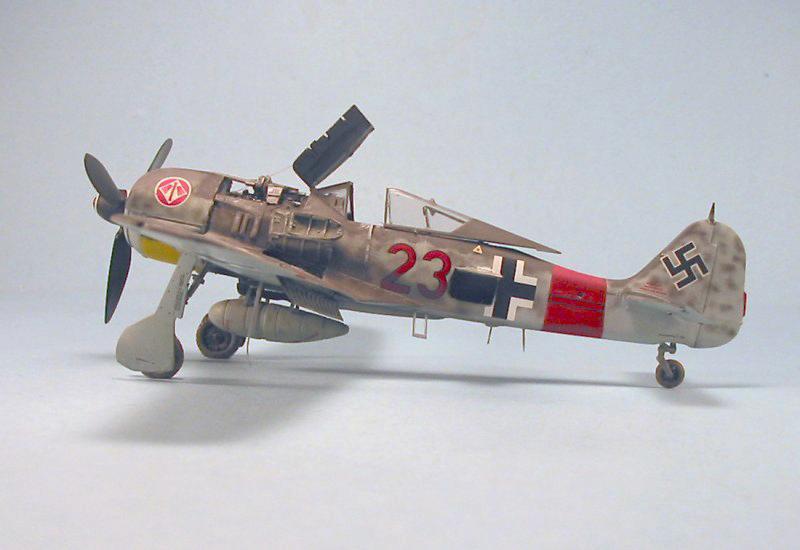
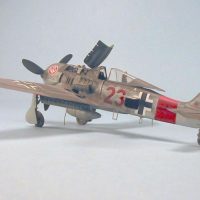
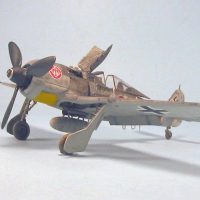

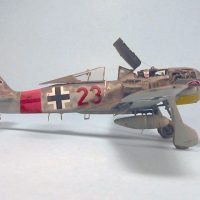
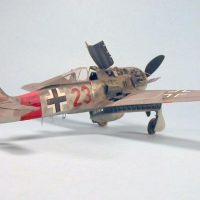
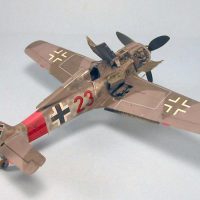
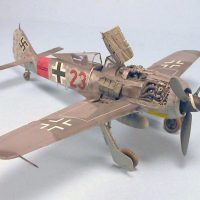
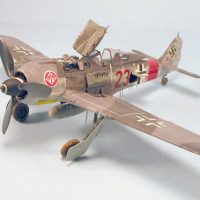
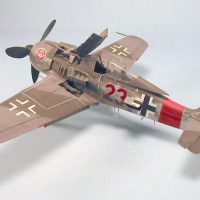
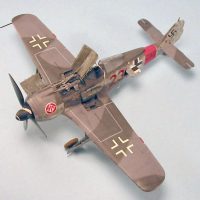

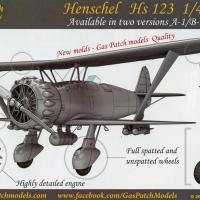

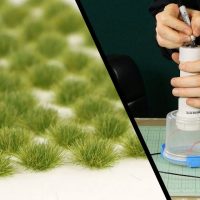
Tom, excellent work here. a worthy project for a good restoration. I like it a lot.
Beautiful Butcher Bird ! Nice bit of history, which is the highlight for me, as well as the model ! Well done as usual.
Great renovation work. Great piece of history too.
It inspired me to read up on Heinz Bär. According to german Wikipedia, a glorifying article about him was written in the May 2000 issue of the National-Zeitung, a nationalist, populist right wing magazine. It's a bit ironic since he was known for his lack of respect for his superiors and committed several acts of disobiedience.
Nice re-build, always a lot of "fun". And an interesting look at a German ace, ironic he died in peacetime.
Beautiful work and the kit definitely worth the restoration. The Dragon Fw190 is still the best kit shape-wise in 1:48 out there - and this example prove that IS buildable 🙂 so I don't beleive the net as You ;). Your modelling skills are great!
Fabulous as always Tom. 🙂
This is what I like about TC's work ...its free and progressive and in a world of people who have Walmart expectations these Micro-Osprey articles go along way in integrating history,people and plastic in showing how relevant our hobby can have teachable moments. While the rest of us poor sods are still holding our rattle cans and photographing models in card board boxes. This article proves that not all of use play with little plastic toys. Bravo to recycling the classics too.
I'm with Towle. Another example of not just a stupid plastic toy. I commend TC for his passion and commitment.
Flattery will get you everywhere... 🙂
Tom - great work! Your skills speak for themselves, as do your ability as a writer. Always enjoy seeing and reading your posts! Thanks for your contribution to a fabulous hobby!
Great model and report Tom, thanks so much sharing your considerable, and multiple, talents
Tom,
Great nice rebuild and I always enjoy the stories.